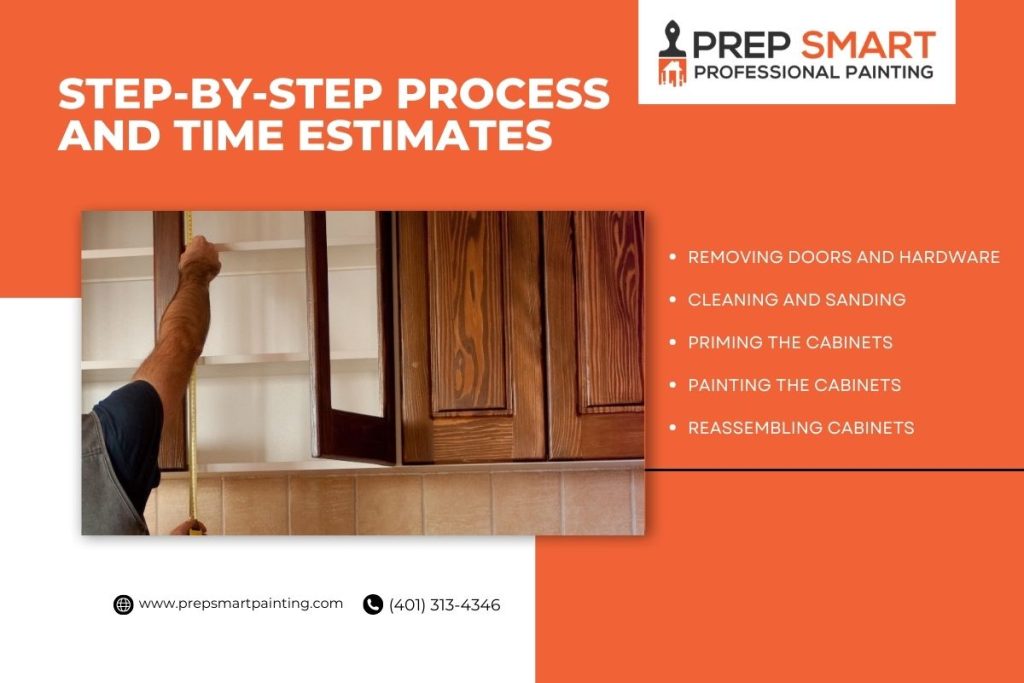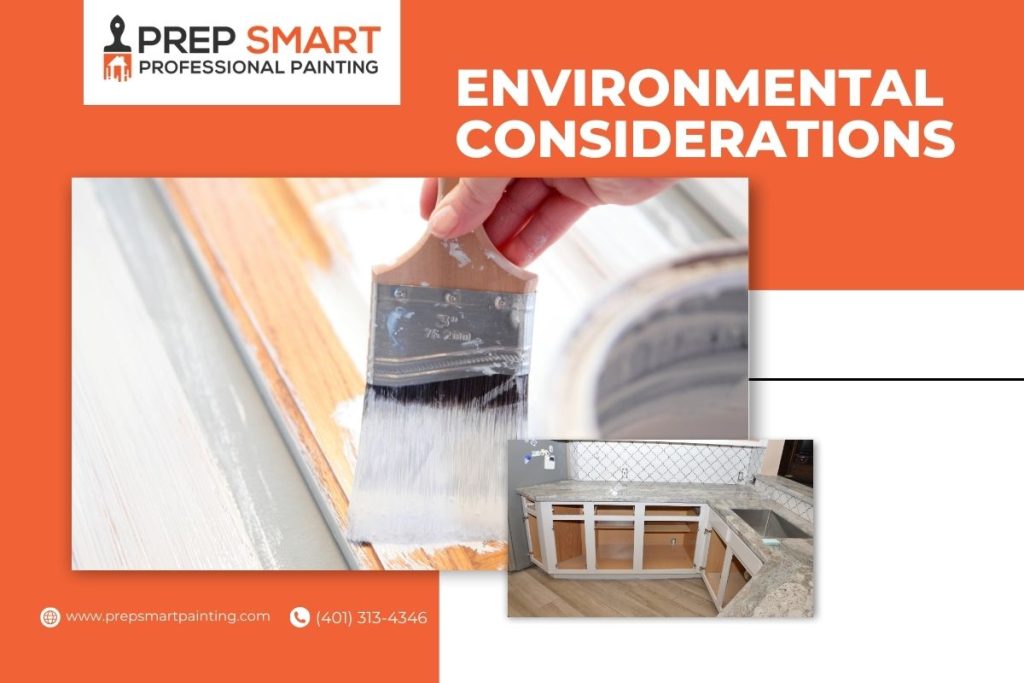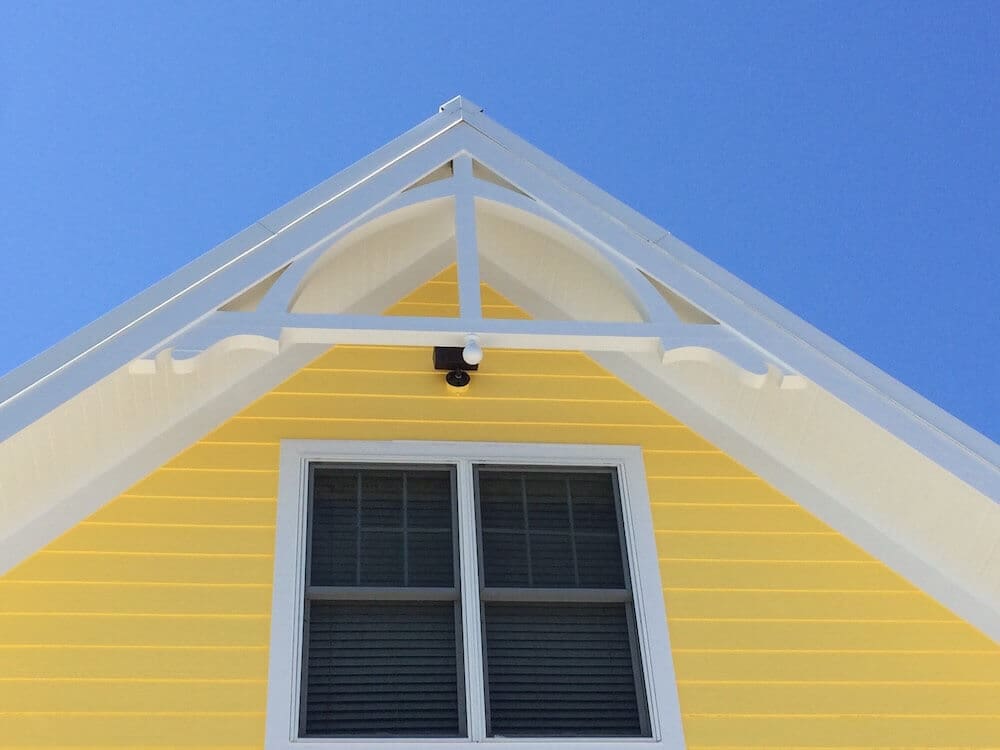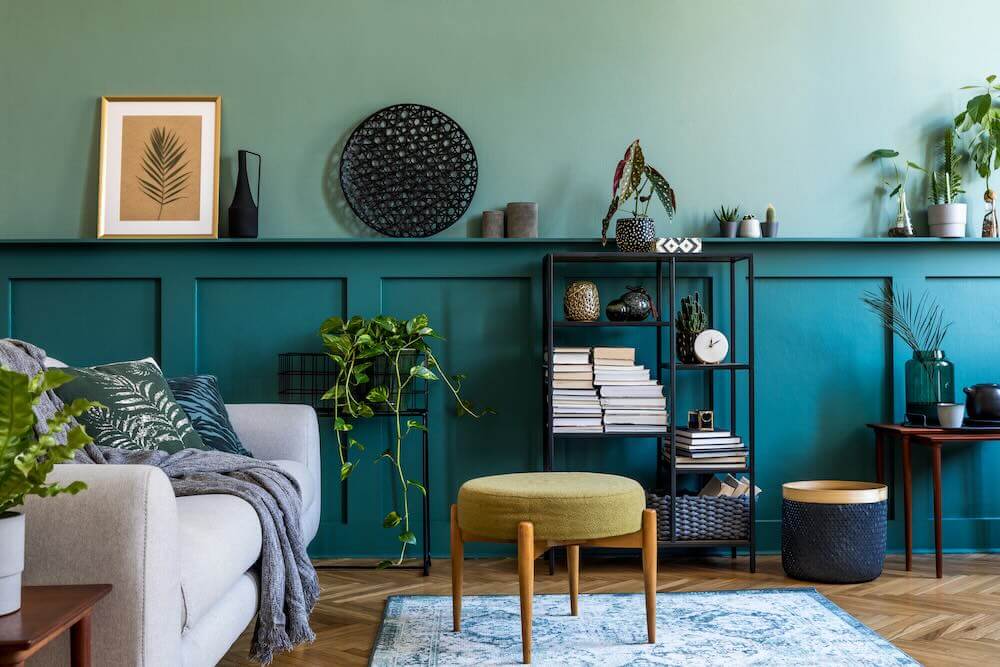
How Long Will It Take to Paint Cabinets?
Table of Contents
Painting cabinets is a popular and cost-effective way to give your kitchen a fresh, updated look without undergoing a full renovation. However, many homeowners wonder, how long will it take to paint cabinets? Understanding the time commitment involved can help you plan your project more effectively. This guide, brought to you by Prep Smart, aims to break down the various factors that affect the painting timeline and provide practical tips for both DIY enthusiasts and those considering professional help. Whether you’re curious about how long it takes to repaint cabinets or seeking advice on how to prep and paint cabinets professionally, this guide will cover all the essential aspects in simple, easy-to-understand language. By the end of this guide, you’ll have a clear understanding of the steps involved and the time required to transform your cabinets.
Factors That Affect the Duration of the Project
When planning to paint your cabinets, several factors will influence like how long will it take to paint cabinets. Understanding these can help you set realistic expectations and plan your time effectively.
- Size of the Project: The number of cabinets you have will significantly impact the time needed. A small kitchen with fewer cabinets will take less time compared to a large kitchen with many cabinets.
- Condition of the Cabinets: If your cabinets are old or have many layers of previous paint, it will take longer to prepare them for painting. Cabinets in good condition require less prep work.
- Preparation Work: Proper preparation is key to a successful paint job. This includes cleaning, sanding, and priming the cabinets. Skipping or rushing these steps can lead to poor results and a longer overall project time.
- Painting Method: The method you choose for painting whether using a brush, roller, or spray gun can affect the time it takes. Spraying is typically faster but requires more preparation and cleanup.
- Drying Time: Paint needs time to dry between coats. The drying time can vary based on the type of paint used and the environmental conditions like humidity and temperature.
- Skill Level: Your experience and skill level will impact the time required. A professional painter may complete the job faster and with a smoother finish compared to a DIY enthusiast.
By considering these factors, you can get a better idea for how long it will take to paint your cabinets and plan your project accordingly.
Factors Influencing Painting Time
When planning to paint your cabinets, several factors will influence how long the project will take. Understanding these can help you set realistic expectations and plan your time effectively. Here’s a detailed look at the key factors:
Cabinet Size and Quantity
The size of your kitchen and the number of cabinets you have play a significant role in determining the time required for the project.
- Small Kitchen (10-15 cabinets): For a small kitchen with fewer cabinets, you can expect the project to take around 3-5 days. This includes time for preparation, painting, and drying.
- Medium Kitchen (15-20 cabinets): A medium-sized kitchen will typically require about 4-7 days to complete. The increase in the number of cabinets means more surfaces to prep, paint, and allow to dry.
- Large Kitchen (20+ cabinets): If you have a large kitchen with more than 20 cabinets, plan for 7-10 days. The extensive work involved will naturally extend the project’s duration.
Condition of Cabinets
The initial condition of your cabinets can significantly impact the time needed to complete the painting job.
- New Cabinets: New cabinets are usually in pristine condition and free from any previous paint or stain. This means they will require less preparation time, such as minimal sanding and no stripping, allowing you to start painting sooner.
- Previously Painted or Stained Cabinets: Cabinets that have been previously painted or stained will require additional time for preparation. This includes stripping off the old paint or stain, sanding the surfaces to ensure smoothness, and possibly repairing any damage. This extra prep work can extend the overall project time.
Desired Finish
The type of finish you want for your cabinets will also affect the duration of the project.
- Basic Finish (1-2 coats): If you’re going for a basic finish with just one or two coats of paint, the drying and application times will be shorter. This makes the project quicker and easier to complete.
- Premium Finish (3+ coats, glaze): A premium finish, which involves three or more coats and possibly a glaze for added effect, will require more time. Each coat needs sufficient drying time before the next one is applied, significantly extending the overall project duration.
Experience Level
Your experience and skill level in painting can greatly influence how long it takes to paint cabinets.
- Beginners: If you’re new to painting cabinets, the project may take longer due to the learning curve. Beginners often need more time to understand the process, gather materials, and execute each step meticulously to avoid mistakes.
- Experienced Painters: Experienced painters, on the other hand, are more familiar with the techniques and tools needed for the job. This efficiency can lead to a faster project completion, as they can work more quickly and confidently through each step.
Understanding these factors will help you better estimate on how long it will take to paint your cabinets. By considering the size and condition of your cabinets, the type of finish you desire, and your own experience level, you can create a realistic timeline for your project.

Step-by-Step Process and Time Estimates
When planning to paint your cabinets, it’s essential to break down the process into manageable steps. This helps in understanding the time commitment for each phase of the project. Here’s a detailed step-by-step guide with time estimates to help you understand on how long will it take to paint cabinets.
Step 1: Removing Doors and Hardware (1-2 hours)
The first step in how to paint cabinets kitchen involves removing all the cabinet doors, drawers, and hardware. This step is crucial to ensure a smooth and even paint job.
- Labeling and Organizing Hardware: Take the time to label each door and its corresponding hardware to make reassembly easier. Organize the screws, hinges, and handles in labeled bags or containers to prevent losing any parts.
Step 2: Cleaning and Sanding (4-6 hours)
Proper preparation is key to achieving a professional-looking finish. This step involves thorough cleaning and sanding of the cabinet surfaces.
- Thorough Cleaning: Clean the cabinets with a degreaser to remove grease, grime, and any residues that can affect the paint adhesion.
- Sanding: Sanding is essential to create a smooth surface for the paint to adhere to. Use fine-grit sandpaper to sand all surfaces, and then wipe away the dust with a damp cloth.
Step 3: Priming the Cabinets (2-4 hours)
Priming is a critical step in how to prep and paint kitchen cabinets as it ensures better paint adhesion and durability.
- Application of Primer: Apply a high-quality primer to all surfaces. This step typically takes 2-4 hours.
- Drying Time: Allow the primer to dry completely, which usually takes about 24 hours.
Step 4: Painting the Cabinets
Painting involves applying one or more coats of paint to achieve the desired finish. Here’s a breakdown of the time estimates for each coat:
- First Coat (2-4 hours): Apply the first coat of paint evenly across all surfaces.
- Drying Time: Let the first coat dry for approximately 24 hours.
- Second Coat (2-4 hours): Apply the second coat to ensure complete coverage and a smooth finish.
- Drying Time: Allow another 24 hours for the second coat to dry.
- Additional Coats (if needed): If you’re aiming for a premium finish with additional coats, each coat will add 2-4 hours of application time plus 24 hours of drying time.
Step 5: Reassembling Cabinets (2-4 hours)
The final step in how to paint kitchen cabinets is reassembling them after ensuring the paint is fully cured.
- Ensuring Paint is Fully Cured: Before reattaching doors and hardware, make sure the paint has cured completely to avoid any smudges or damage.
- Reattaching Doors and Hardware: Carefully reattach all the doors, drawers, and hardware, following the labels you created during disassembly. This process usually takes 2-4 hours.
Detailed Timeframes
When planning to paint your cabinets, it’s essential to understand the detailed timeframes for each phase of the project. Here’s a comprehensive breakdown to help you estimate the total time required:
Preparation Phase
The preparation phase involves several key steps to ensure your cabinets are ready for painting. Proper preparation is crucial for achieving a smooth and long-lasting finish.
- Removing Doors and Hardware: This step typically takes 1-2 hours. Labeling and organizing hardware properly will save time during reassembly.
- Cleaning and Sanding: Thoroughly cleaning and sanding the cabinets can take around 4-6 hours. This step is essential for removing grease and grime and creating a smooth surface for painting.
Total Time for Preparation Phase: 1-2 days
Painting Phase
The painting phase is where you apply primer and multiple coats of paint, allowing for proper drying times between each coat.
- Priming: Applying primer to all cabinet surfaces takes about 2-4 hours. The primer then needs to dry for approximately 24 hours.
- First Coat of Paint: The first coat typically takes 2-4 hours to apply, followed by a 24-hour drying period.
- Second Coat of Paint: The second coat also takes 2-4 hours to apply, with another 24-hour drying period.
- Additional Coats (if needed): Each additional coat will add 2-4 hours of painting time plus 24 hours of drying time.
Total Time for Painting Phase: 2-4 days
Reassembly Phase
Once the paint is fully cured, you can reattach the doors and hardware. This final phase ensures your cabinets are ready for use.
- Reattaching Doors and Hardware: This step generally takes 2-4 hours, depending on the number of cabinets and the complexity of the hardware.
Total Time for Reassembly Phase: 1 day
Overall Time Estimates
Combining the time required for each phase gives you a comprehensive estimate of the total project duration based on the size of your kitchen:
- Small Kitchen (10-15 cabinets): Expect the project to take around 3-5 days, including preparation, painting, and drying.
- Medium Kitchen (15-20 cabinets): The project will likely require 4-7 days, accounting for additional cabinets and extended drying times.
- Large Kitchen (20+ cabinets): Plan for 7-10 days to complete the job, considering the extensive work and multiple coats needed for a larger space.

Environmental Considerations
When painting cabinets, weather conditions, humidity, and temperature can significantly impact the drying process and the quality of the finish. PrepSmart Painting recommends these tips to help you navigate these environmental factors.
Temperature
- Optimal Temperature Range: The best temperature for painting is between 50°F and 85°F (10°C to 29°C). Paint dries best in moderate temperatures.
- Cold Weather: Painting in cold weather can slow down the drying process and affect the adhesion of the paint. If you must paint in cooler temperatures, ensure the room is adequately heated and allow extra time for drying.
- Hot Weather: High temperatures can cause the paint to dry too quickly, leading to brush marks and an uneven finish. If painting in hot weather, work in the early morning or late evening when temperatures are cooler and keep the workspace well-ventilated.
Humidity
- Low Humidity: Low humidity levels are generally good for painting, as they promote faster drying times. However, extremely low humidity can cause paint to dry too quickly, resulting in brush marks.
- High Humidity: High humidity levels slow down the drying process and can lead to issues like bubbling and poor adhesion. Use a dehumidifier to reduce moisture levels in the air if you are painting in a high-humidity environment.
Ventilation
- Proper Airflow: Ensure your painting area is well-ventilated. Good airflow helps to speed up drying times and reduces the concentration of fumes. Use fans or open windows to improve ventilation.
- Avoid Dust and Debris: Proper ventilation also helps to minimize dust and debris settling on the wet paint, which can affect the finish quality.
Weather Conditions
- Rainy Weather: Avoid painting during rainy or excessively damp weather, as the high moisture levels in the air can extend drying times and impact paint adhesion.
- Windy Conditions: If you are painting outdoors or in a space with open windows, be mindful of wind, which can carry dust and debris onto your wet surfaces.
Tips to Reduce Time
Reducing the time it takes to paint cabinets while still achieving a professional finish is possible with some strategic planning and efficient techniques. Here are some tips to help you speed up the process:
- Organization: Label and group parts to streamline reassembly. This will save you time and prevent confusion when it’s time to put everything back together.
- Use Time-Saving Tools: Use electric sanders and paint sprayers for faster preparation and painting. These tools can significantly cut down on manual labor and improve efficiency.
- Efficient Techniques: Opt for quick-drying primers and paints to reduce waiting times. Paint doors and frames simultaneously to allow for parallel drying, which helps in finishing the job quicker.
- Avoiding Common Pitfalls: Ensure proper ventilation to speed up drying times. Stick to recommended drying times to avoid issues such as tackiness or uneven finishes.
Conclusion
The time required to paint cabinets depends on several factors, including the size of your kitchen, the condition of the cabinets, the desired finish, and your experience level. Smaller kitchens may take around 3-5 days, medium kitchens 4-7 days, and larger kitchens 7-10 days. Proper organization, using the right tools, and avoiding common mistakes can help streamline the process and reduce the overall time required. By planning carefully and following best practices, you can achieve a professional-looking finish within a realistic timeframe.
This blog has provided a comprehensive guide on how long will it take to paint cabinets, covering each phase of the project from preparation to reassembly. We’ve also included tips to reduce time and common mistakes to avoid, ensuring you are well-equipped to tackle your cabinet painting project efficiently. By understanding these elements, you can better estimate the time commitment and approach the task with confidence, ultimately transforming your kitchen with beautifully painted cabinets For more detailed information, check out our blog on “How to Paint Cabinets.” These articles provide additional insights and tips that can further help streamline your cabinet painting project with Prep Smart.
FAQs
Can I paint my cabinets in one day?
While it’s theoretically possible to paint cabinets in one day if you use quick-drying paint, it’s not recommended. Proper preparation, drying times, and multiple coats usually extend the project to several days to ensure a high-quality finish.
How many coats of paint are typically needed for cabinets?
Most cabinets require at least two coats of paint for full coverage. However, depending on the paint color and the desired finish, you might need a third coat.
Do I need to wait for each coat of paint to dry before applying the next one?
Yes, it’s essential to allow each coat of paint to dry completely before applying the next. Typically, this drying time is about 24 hours per coat, but always refer to the paint manufacturer’s recommendations.
Can I speed up the drying process?
You can speed up the drying process by ensuring proper ventilation, using fans, or working in a warm, dry environment. However, avoid rushing the drying process as it can affect the paint’s adhesion and finish.
How long should I wait before reassembling my cabinets?
After the final coat of paint, it’s best to wait at least 24-48 hours before reassembling the cabinets to ensure the paint is dry to the touch. For full curing, which ensures the paint is fully hardened, you might need to wait up to a week.
Does the type of paint affect the drying and overall project time?
Yes, the type of paint significantly affects drying times and overall project duration. Quick-drying paints can reduce waiting times, but high-quality finishes often require longer drying and curing periods.






